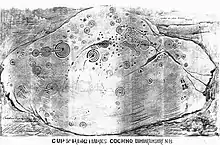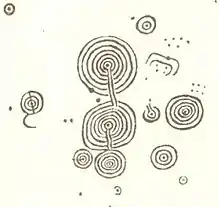Cochno Stone
The Cochno Stone is a large cup and ring marked rock at Auchnacraig, Faifley, West Dunbartonshire, Scotland,[1] next to the Cochno farm.[2] It is also known variously as "Whitehill 1"[3]: 9 and "the Druid Stone".[3]: 2

Sketch by W. A. Donnelly (dated 1895) of the Cup & Ring marks on the Cochno Stone. Published by John Bruce in 1896

Detail sketched by James Harvey of Duntocher in 1889
The Bronze Age rock art is found on a stone measuring 42 by 26 feet (12.8 by 7.9 metres), and was documented in 1887 by the Rev. James Harvey.[3]: 3 It features around 90 carved indentations, considered to be one of the finest sets of petroglyphs in Scotland.[4]
The stone was reburied in 1965 to protect it against vandalism. In 2015 it was partially re-exposed for investigation during a 3-day dig by a team involving archaeologists from the University of Glasgow,[5] with a more complete re-exposure following a year later.[6]
References
- Historic Environment Scotland. "Whitehill: Cup And Ring Marked Rock (44535)". Canmore. Retrieved 5 August 2016.
- "Dig to unearth prehistoric Cochno Stone". BBC News. 7 September 2016. Retrieved 1 October 2017.
- Brophy, Kenneth (March 2018). "'The finest set of cup and ring marks in existence': the story of the Cochno Stone, West Dunbartonshire" (PDF). Scottish Archaeological Journal. 40 (1). doi:10.3366/saj.2018.0092. ISSN 1471-5767.
- Brown, Craig (17 July 2014). "5000-year-old Cochno Stone carving may be revealed". The Scotsman. Retrieved 5 August 2016.
- "Historic Cochno Stone uncovered by archaeologists". Clydebank Post. 17 September 2015. Retrieved 5 August 2016.
- "Fire crews fighting mud for Cochno Stone archaeologists". BBC News. 12 September 2016. Retrieved 12 September 2016.
External links
- "Site photograph: detail of markings". Canmore. Historic Environment Scotland. Retrieved 5 August 2016.
- Cochno on CANMORE, Historic Environment Scotland. Retrieved 6 October 2017.
- High-resolution image viewer of the Cochno Stone by Factum Foundation for Digital Technology in Conservation.
This article is issued from Wikipedia. The text is licensed under Creative Commons - Attribution - Sharealike. Additional terms may apply for the media files.